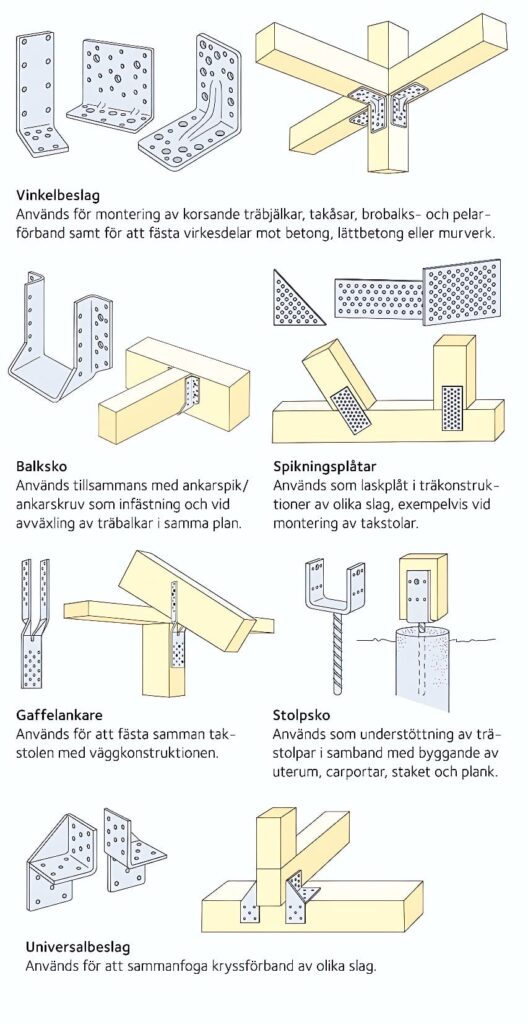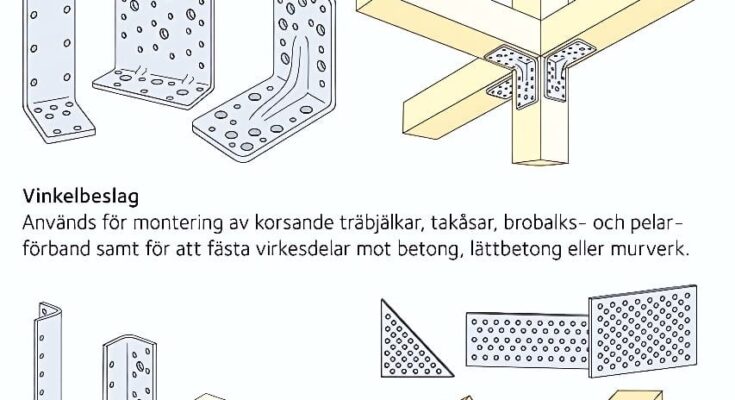This image serves as a valuable visual guide to a diverse array of metal connectors commonly employed in timber construction. Each illustrated connector type is accompanied by a descriptive label (in Swedish) outlining its name and primary applications. These connectors play a critical role in ensuring the structural integrity, stability, and longevity of wood-framed buildings and structures by providing robust and reliable connections between various timber members. From joining perpendicular beams to securing posts to foundations, this compendium showcases the essential hardware that underpins safe and durable wood construction.
1. Vinkelbeslag (Angle Brackets):
- Visual Description: The top left section displays several variations of angle brackets. These are typically L-shaped metal plates with pre-drilled holes to accommodate nails or screws. The brackets vary in size, thickness, and the number and pattern of holes, suggesting different load-bearing capacities and application requirements. Some variations include additional bends or gussets for increased strength and rigidity.
- Application: The accompanying text states that “Vinkelbeslag” are used for mounting crossing timber members, trusses, roof structures, beams, and posts. They are also used to fasten wooden parts to concrete, lightweight concrete, or masonry. This highlights the versatility of angle brackets in providing strong and secure right-angle connections in various timber framing scenarios and for anchoring wood to non-wood materials. It is within this category of “Vinkelbeslag” that a product similar in function to the Simpson Balkenschuh BSDI 160×160 would likely be found, although the exact model is not identifiable in this image.
2. Balksko (Joist Hanger):
- Visual Description: Located in the middle left, the “Balksko” is a U-shaped metal connector designed to support the end of a joist or beam. It features flanges with pre-drilled holes for fastening to a supporting member, such as a ledger board or another beam. The joist or beam is then inserted into the U-shaped cradle and secured with nails or screws through the hanger’s sides.
- Application: The text explains that “Balksko” are used together with anchor nails (“ankarspik”) or anchor screws (“ankarskruv”) for the attachment and transfer of loads from timber beams that are level with each other. This is a fundamental connector in floor and roof framing, ensuring that joists and beams are securely supported and that loads are effectively transferred to the supporting structure. The Simpson Balkenschuh BSDI 160×160 is a specific type of joist hanger and would fall under this general category.

3. Gaffelankare (Truss Girder Hanger/Fork Anchor):
- Visual Description: Situated at the bottom left, the “Gaffelankare” features a forked or split design with pre-drilled holes for fasteners. It is used to connect a truss to a wall construction. The illustration shows one part of the anchor attached to the top plate of a wall, and the forked ends are designed to receive and secure the bottom chord of a truss.
- Application: The text confirms that “Gaffelankare” are used for fastening trusses to wall constructions. This type of connector provides a strong and stable connection point for roof trusses, ensuring they are securely anchored to the supporting walls and can effectively transfer roof loads.
4. Universalbeslag (Universal Bracket):
- Visual Description: Found at the very bottom, the “Universalbeslag” appears as a versatile angle bracket with multiple planes and a variety of pre-drilled holes and slots. Its design suggests it can be adapted to connect timber members at various angles, not just 90 degrees.
- Application: The text indicates that “Universalbeslag” are used for joining crossing timber members at an angle. This highlights its flexibility in handling non-perpendicular connections, which can occur in more complex timber framing designs or when joining diagonal bracing.
5. Spikningsplåtar (Nailing Plates/Gusset Plates):
- Visual Description: Located in the middle right, “Spikningsplåtar” are thin metal plates with numerous sharp protrusions or teeth. These plates are embedded into the surface of timber members to create strong connections, typically in prefabricated timber structures like trusses. The illustration shows a plate joining two angled timber members.
- Application: The text explains that “Spikningsplåtar” are used as connecting plates in timber constructions, for example, in the assembly of roof trusses (“takstolar”). These plates provide a large surface area for load transfer through the embedded teeth, creating a strong and efficient joint.
6. Stolpsko (Post Base):
- Visual Description: Displayed at the top right, “Stolpsko” are metal bases designed to support timber posts. They often feature a U-shaped or cupped receptacle for the bottom of the post and a base plate with holes for anchoring to concrete or other foundations. Some variations include standoffs to elevate the post above the ground, preventing moisture damage.
- Application: The text states that “Stolpsko” are used as supports for wooden posts in connection with outdoor constructions, carports, fences, and decks (“plank”). Elevating the posts helps to protect them from ground moisture and decay, significantly extending their lifespan in exposed environments.
In conclusion, this image provides a concise yet informative overview of essential timber connectors. Each type, including the general category where the Simpson Balkenschuh BSDI 160×160 (a joist hanger, falling under “Balksko”) and similar angle brackets (“Vinkelbeslag”) belong, is specifically designed to address different connection requirements in wood framing, ensuring the structural integrity, stability, and safety of the final construction. The use of appropriate connectors, installed correctly, is paramount in creating durable and reliable timber structures.



